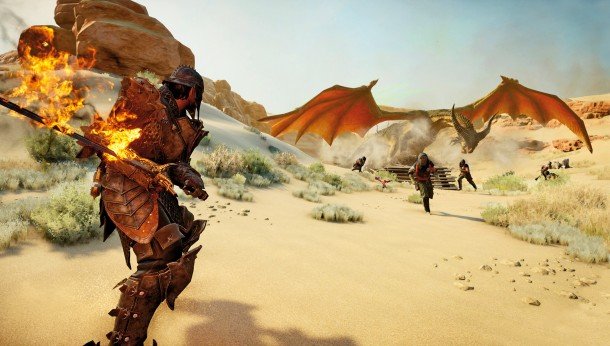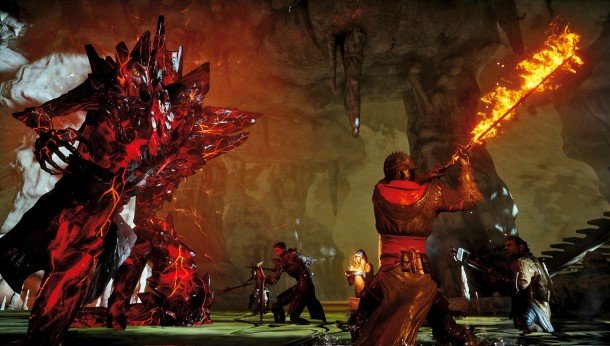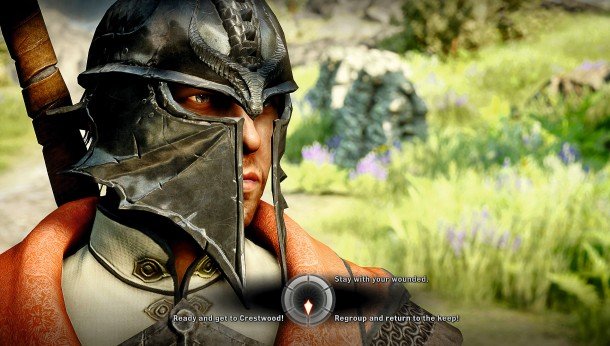Dragon Age: Inquisition first look - on returning characters and open world fortresses

Dragon Age has never had the same sense of direction as Mass Effect. Its sci-fi stablemate was a point-to-point race through a single narrative, escalating in scale as success translated into publisher support. Dragon Age: Origins was, in many ways, the last game from pre-EA BioWare, an oldschool fantasy RPG that grew organically over a protracted development period. Its popularity seemed to catch the studio's new publisher off-guard, leading to a sequel that – while it retained much of its predecessor's soul – lost all of its scope.
“We have a much greater opportunity in terms of time on this one than we did on DAII,” says producer Cameron Lee, who joined BioWare from Dead Space developers Visceral Games in early 2012. “We also have the opportunity with the engine change to rebuild everything from the ground up. We're trying to bring across the same feel, the same vibe, and the same sort of storytelling, but DAII was more of a framed narrative – Inquisition is definitely Origins-style. Much bigger.”
'Origins-style' scope doesn't mean oldschool, however: what I've seen of Inquisition indicates a modern game that wears its influences – and ambitions – openly. The first area I'm shown is an open-world take on Ferelden, an expanse of fields and frosty mountainsides that suggests that the success of Skyrim hasn't gone unnoticed. It's still Dragon Age, however, and the party-of-four system and adjustable third-person perspective all reflect that. Combat is broadly similar to Dragon Age II, but the pause interface has been improved to allow for more fluid issuing of orders before time resumes. You'll still be able to program friendly AI behaviour, but this wasn't shown.

Dragon Age: Origins introduced the Warden, DAII starred the Champion, and Inquisition will be led by, well, the Inquisitor. You are an individual given charge of a fledgling faction after the Veil – the barrier between the real world and the realm of dreams and magic – is torn apart by a mysterious enemy. The Inquisitor can be male or female, and either human, dwarf, elf, or – for the first time in the series – a grey-skinned qunari giant. The Inquisitor I saw was human, male and fully voice-acted.
The party you assemble over the course of the game will include, according to Lee, “a significant returning cast.” In the demonstration, the Inquisitor was joined by Varric Tethras, DAII's dwarven narrator, and Cassandra Pentaghast. Cassandra was the character who interrogated Varric in the second game's framing narrative, and her presence suggests that the two have found some kind of common cause. The fourth character was Vivienne, a mage and First Enchanter of one of the Orlesian Circles. If you've been following the series, you'll be able to piece together what this says about the Inquisition itself: that it's removed from the broader conflict between Templars and mages, for one, and also that its direction is shaped by the player's own preferences and affiliations.

The nature of the Inquisition will affect the resources the player has available. There'll be multiple open-world zones in the game, representing an area of Thedas that includes Ferelden, Orlais, Nevarra and the Free Marches. Securing territory for the Inquisition in each zone is a key activity, based around the capture of a network of fortresses. I was shown a desert area west of Orlais where a series of side objectives – poisoning water supplies, raiding caravans – culminates in the brief siege of a rundown Grey Warden outpost. Once claimed, the player has the choice to transform the outpost into a military fortress, an espionage centre, or a mercantile hub. Fortresses also grant the player access to agents, who can be assigned to various tasks to expand the Inquisition's power base. Examples given included rebuilding an ancient colossus to stand as a testament to the faction's strength, or reopening an old Tevinter gate to access a new area.
This system encapsulates the ways that Inquisition builds on the foundations of its predecessors. The player's faction has always been key: in Origins, you were tasked with rebuilding the shattered Ferelden Grey Wardens, and Dragon Age II is, in essence, the story of a revolutionary cell forming in a backwater town. The Inquisition is the logical next step, giving the player charge of a Wardens-style company from its outset and letting them decide what kind of organisation it turns out to be. At the same time, it also demonstrates that BioWare have been paying attention to how open-world action games like Assassin's Creed: Brotherhood have approached the same topic. It might upset purists, but it's promising nonetheless.
The biggest gaming news, reviews and hardware deals
Keep up to date with the most important stories and the best deals, as picked by the PC Gamer team.

“Changing with the times is certainly an influence,” Lee says. “The open world is a trend that we see in a lot of genres – there's a level of technology you can get to where you can open up experiences you couldn't do previously. We think we've found a way to present a really strong narrative in an open world.”
The key new technology in this case is the Battlefield-powering Frostbite engine which makes its RPG debut in Dragon Age: Inquisition. It brings environmental destruction and previously-impossible landscapes to the series: stick some pylons and a fighter jet in Ferelden and it could be Caspian Border. Nevertheless, it still looks like Dragon Age: the characters and equipment are substantially more detailed but the art style hasn't changed. It bodes well for Mass Effect 4, which will be built on the same engine, but for the first time it feels like it's Dragon Age leading the way into the future.
Joining in 2011, Chris made his start with PC Gamer turning beautiful trees into magazines, first as a writer and later as deputy editor. Once PCG's reluctant MMO champion , his discovery of Dota 2 in 2012 led him to much darker, stranger places. In 2015, Chris became the editor of PC Gamer Pro, overseeing our online coverage of competitive gaming and esports. He left in 2017, and can be now found making games and recording the Crate & Crowbar podcast.


